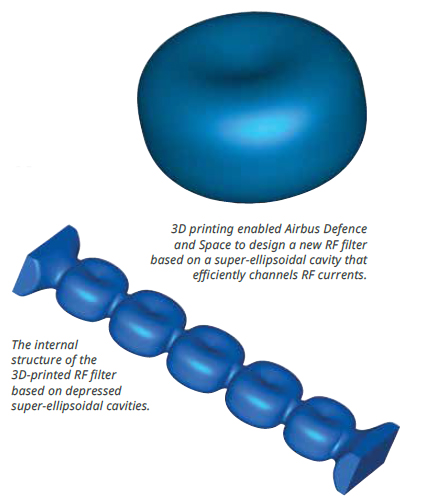 Airbus Defence and Space has worked with 3D Systems to achieve a major breakthrough: The first 3D printed radio frequency (RF) filter tested and validated for use in commercial telecommunications satellites as outlined in their latest case study. The project built upon research funded by the European Space Agency (A0/1-6776/11/NL/GLC: Modelling and Design of Optimized Waveguide Components Utilizing 3D Manufacturing Techniques).
Airbus Defence and Space has worked with 3D Systems to achieve a major breakthrough: The first 3D printed radio frequency (RF) filter tested and validated for use in commercial telecommunications satellites as outlined in their latest case study. The project built upon research funded by the European Space Agency (A0/1-6776/11/NL/GLC: Modelling and Design of Optimized Waveguide Components Utilizing 3D Manufacturing Techniques).
A major industry trend is to increase the capacity for multiple beams within a single satellite. A high-capacity satellite such as the Eutelstat KA-SAT manufactured by Airbus Defence and Space carries nearly 500 RF filters and more than 600 waveguides. Many of these are custom-designed to handle specific frequencies.
3D Systems has been using the 3D Systems ProX DMP 320 since the machine was in its beta stages. Successful projects include topological optimization, weight reduction and parts consolidation for spaceflight validated parts such as brackets and strut end fittings for telecommunications satellites. The Airbus Defence and Space project was 3D Systems Leuven’s first foray into RF filters. The ProX DMP 320 is designed for heavy-duty metal parts production. It uses a totally new architecture that simplifies set-up and provides the versatility to produce all types of part geometries in titanium, stainless steel, aluminum, nickel-chromium and other alloys.
CST MWS was used to design the 3D printed RF filters, with little time spent on optimization. The increased manufacturing flexibility enabled by 3D printing led to a design using a depressed super-ellipsoidal cavity. The unique shaping helped to channel RF currents and deliver the required tradeoffs between Q factor — a measure of a waveguide’s efficiency based on energy lost — and rejection of out-of band signals.
Initially, the different surface topology in 3D printed metal parts was thought to be an issue, but extensive testing by Airbus Defence and Space eliminated those concerns. Machined surfaces have sharp peaks and troughs, while the 3D printed surface is spheroids melted together so there is less sharpness and the ability to shape a part for more effective signal filtering more than overcomes any concerns with surface topology.
Three aluminum samples printed on the ProX DMP 320 using different processing paths were tested by Airbus Defence and Space at its Stevenage facilities. Tests mimicked conditions the parts would face during launch and orbit, including vibration, shock and thermal situations such as temperature extremes and vacuum conditions. All three samples met or exceeded requirements, with the best performance coming from a filter that was silver-plated via an electrolytic process.

The success of this project opens up the possibility of much greater integration of RF filters with mechanical and thermal components to reduce part count and overall mass. We will also look at integrating more functionality such as test-couplers as part of the filter or directly integrated into waveguide runs. There is a huge potential for reducing mass while cutting production time and costs.
The end benefits were the consolidation of 2 parts into 1 reducing overall mass, 50% reduction in weight plus faster production time and reduced costs. We look forward to following this technology and other additive manufacturing processes affecting our industry.

